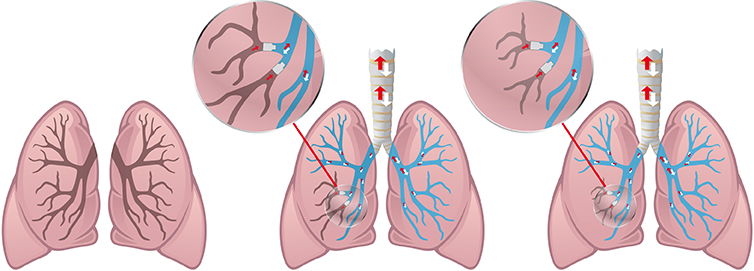Endobronchial Valves: surgical methods for COPD
Effect of endobronchial valves on the lungs
Endobronchial valves are inserted into the central airways of a lobe of the lung under general anaesthesia using an insertion catheter. These valves are the size of a thumb tip (4-8mm) and close the supplying bronchi of the lobe of the lung that is most affected by the overinflation of the alveoli. As a result, no further air can enter the now closed lung area when breathing in, but secretions and air can escape (valve effect). The ventilated/affected lung area shrinks and there is a tendency to collapse (lung collapse). A special test is used to find out whether the lungs of the COPD patient are suitable for valve implantation. Less than 50% of the COPD patients tested are said to be suitable for the valves.
After valves have been implanted, many patients report that the valves are sometimes coughed up when they cough. Valves can be removed at any time.

To get to the point:
COPD sufferers are advised/prescribed to take a wide variety of COPD medications every day for years, which cause or contribute to over-inflation of the alveoli! Then, when emphysema is present and COPD medications cannot further over-inflate, surgical methods such as valves or coils are recommended to reduce or contract the over-inflated lung tissue again to allow over-inflation in other areas of the lungs. This is a very specific logic that we cannot understand and does not follow bio-logic.
An honest and open discussion with patients who have had valves or coils in their lungs for weeks and months (long-term experience) can support their own decision-making process for or against such surgical methods.
Note:
The classic COPD drugs have a sympathicotonic effect. This means that the already stressed COPD patient is artificially inflicted with even more stress/continuous stress in order to expand the alveoli and bronchi even more, or more precisely, to overinflate them even more, day after day. Repair and regeneration processes in the lung tissue are biologically impossible with this therapy!
Reading tip
In COPD therapy, further surgical procedures for lung volume reduction (LVR) are recommended and used in advanced stages and in cases of permanent shortness of breath: RePneu Coils
